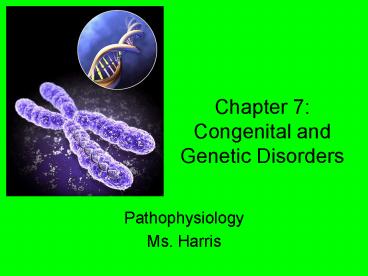Chapter 7: Congenital and Genetic Disorders - PowerPoint PPT Presentation
1 / 23
Title:
Chapter 7: Congenital and Genetic Disorders
Description:
Chapter 7: Congenital and Genetic Disorders Pathophysiology Ms. Harris Congenital/Genes Congenital= defects or damage to a developing fetus that are present at birth ... – PowerPoint PPT presentation
Number of Views:603
Avg rating:3.0/5.0
Title: Chapter 7: Congenital and Genetic Disorders
1
Chapter 7Congenital and Genetic Disorders
- Pathophysiology
- Ms. Harris
2
Congenital/Genes
- Congenital defects or damage to a developing
fetus that are present at birth - Genetic abnormalities
- Malformation
- Chromosomal abnormalities
- Genes- are segments of DNA that code for a
specific trait. DNA is what makes up chromosomes.
3
(No Transcript)
4
Chromosomes
- Humans have 23 pairs. (23 from egg, 23 from
sperm that join together to form the zygote) - Karyotypes show all pairs
- 1-22 Autosomes
- 23rd pair sex chromosomes
5
Normal female
Normal male
6
Chromosomal Disorders
- Can be diagnosed by identifying abnormalities on
a karyotype. - Failure of chromosomes to separate in meiosis
non-disjunction (result is either a monosomy or
trisomy) - Translocations, deletions of chromosomes can also
occur
7
- Can you spot the abnormality?
8
Trisomy 21
- More commonly called Down Syndrome
- Causes mental retardation, shortened lifespan,
oblique eye, smaller chin - 1 in 1000 births
9
- Can you spot the abnormality?
10
Turners syndrome
- Malfunctioning ovaries, sterility, heart defects,
short stature - 1 in 2500 female births
11
- Can you spot the abnormality?
12
- Can you spot the abnormality?
13
Congenital Defects, cont.
- Sometimes, just a single gene is affected.
- Sometimes, they are multifactorial
14
Congenital Disorders, cont.
- Can be inherited or caused by teratogenic agents
- Things that cause damage to the fetus
- Smoke, alcohol, etc.
15
Punnett Squares
- Used to predict chances for having a child with
one of the following types of disorders - Autosomal dominant, autosomal recessive,
sex-linked dominant, sex-linked recessive
16
Punnett Square Review
- Autosomal recessive(ex. Cystic fibrosis)
- What are the chances that an affected female and
a normal (homozygous) male will have a child with
cystic fibrosis?
17
Punnett Square Practice
- Autosomal dominant (ex. Huntingtons)
- What is the probability that and affected
(heterozygous) parent and a normal parent will
have a child born with Huntingtons disease?
18
Punnett Square Practice
- X- linked disorder (duchennes muscular
dystrophy) - What is the probability that a carrier female and
a normal male will have a child born with MD?
19
Pedigree Practice
20
Multifactorial Disorders
- Lots of things factor into the expression of the
disease - Many genes
- Environmental factors
- Etc.
21
Developmental Disorders
- Anomalies can be caused by exposure to
teratogens. - Mercury, alcohol, many chemicals
- First 2 months are the most critical because
cells are differentiating (organogenesis) - Cerebral Palsy
22
Diagnostic Tools
- Amniocentesis for prenatal diagnosis
- Neonatal blood testing following birth
- Most hospitals make several tests mandatory
23
Gene therapy
- Current Event Analysis
- Name 3 cause/effects from the article.
- Make a T-chart to list pros and cons of gene
therapy. (think beyond the article!)

